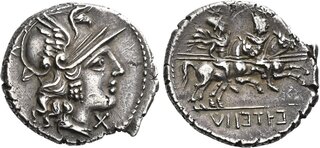| Numismatica Ars Classica > Auction 143 | Auction date: 7 May 2024 |
| Lot number: 153 Price realized: This lot is for sale in an upcoming auction - Bid on this lot  | Show similar lots on CoinArchives Find similar lots in upcoming auctions on |
| Lot description: The Dioscuri Collection. The Roman Republic. The Bellum Sociale. Denarius, Corfinium circa 90, AR 18 mm, 3.88 g. Helmeted head of Italy r.; below chin, X. Rev. The Dioscuri galloping r.; in exergue, viteliú retrograde in Oscan characters. Sydenham 625. Campana 1e (this coin). Historia Numorum Italy 422. Extremely rare and among the finest specimens known. Wonderful old cabinet tone and good extremely fine Ex M&M Cahn 17 July 1933, Haeberlin, 1459; Münzhandlung Basel Fixed Price List January 1934, 57; M&M 38, 1968, 133; M&M 66, 1984, 362 and NAC 70, 2013, 95 sales. After decades of providing the military backbone of Roman expansion, the Italic allies (socii in Latin) of Rome felt that they deserved more of the benefits than they had previously received. In short, they wanted Roman citizenship so that they would have a greater say in Rome's wars of conquest and changes to the system of land distribution that had concentrated vast swathes of arable land in the hands of the Roman elite. The disenchantment of the Italic socii with Rome came to a head in 91 BC, when M. Livius Drusus was murdered, probably through the agency of the consuls L. Marcius Philippus and Sextus Julius Caesar. He had been championing Italic rights and had drawn a large following as a means of forcing through a variety of social reforms in opposition to the consuls. This bloodshed sparked the Italic peoples, who may or may not have previously sworn an oath to be the protectors of Drusus, to give up their status as Roman allies and form an independent federal state known as the Italic Confederation with a capital at Corfinium, which was renamed Italica. Although the confederation included the Frentani, Hirpini, Iapygii, Lucanians, Marrucini, Marsi, Paeligni, Picentines, Pompeians, Samnites, Venusians, and Vestini, leadership was primarily in the hands of the Marsi and Samnites. Raising an army of 120,000 men, in 90 BC, the Italic consuls Q. Poppaedius Silo and C. Papius Mutilus and began a war against the Romans in the north and in the south, respectively. The Marsi defeated and killed P. Rutilius Lupus, the Roman consul sent against them, while at the same time, Mutilus made inroads into Campania, Lucania, and Apulia, drawing several additional cities and peoples into the Italic Confederacy. Although the Roman consul L. Julius Caesar, managed to roll back much of the Italic advance in the south, Rome remained in crisis. Fearing that other socii might break their alliances with Rome and join the rebels, Caesar enacted a law giving full rights of Roman citizenship to allied cities and peoples who had not already entered the Social War. In 89 BC, another law, the lex Plautia Papiria expanded Roman citizenship to any Italic ally who lay down his arms, in the hope of drawing support away from the Italic Confederacy. Everything began to fall apart for the Italic Confederation in 89 BC, despite the Marsic victory over the Roman consul L. Porcius Cato at the Battle of the Fucine Lake. Shortly thereafter, the Marsi suffered a series of defeats at the hands of Cato's colleague, C. Pompeius Strabo, and Sulla largely destroyed the forces of C. Papius Mutilus in Campania. In 88 BC, the war essentially came to an end when the Marsi were defeated and Q. Popaedius Silo killed at the Battle of the Teanus River. All that remained was for the Romans to mop up remaining pockets of resistance in Samnium in 87 BC. The Italic Confederation was no more, but at least part of its demands had been met and Rome would be more careful with its allies in the future. The denarii of the Italic Confederation struck during the Social War are notable for their close imitation of Roman denarii with the usual legend ROMA replaced by ITALIA in Oscan script. Somewhat ironically, this particular coin imitates a Roman Republican issue featuring the Dioscuri on the reverse. These gods were venerated by the Romans for their miraculous appearance at the Battle of Lake Regillus in 509 BC. This battle ended in Roman victory over the neighbouring Latins and the expelled Etruscan king L. Tarquinius Superbus. It seems a little unexpected to employ types related to a Roman victory over surrounding Italic peoples at a time when the Italic peoples were rising up to strike against the Romans. Estimate: 6000 CHF |  |



